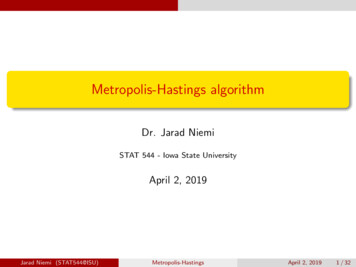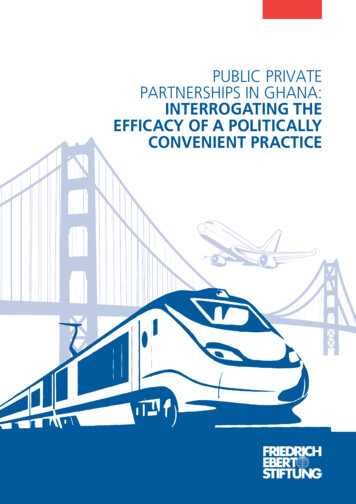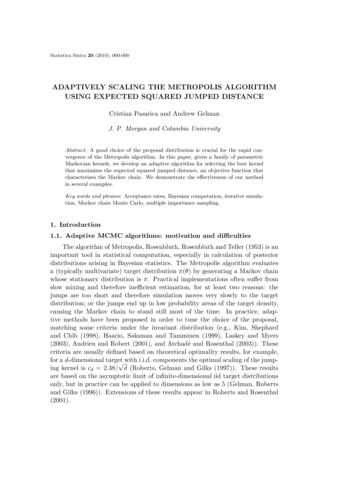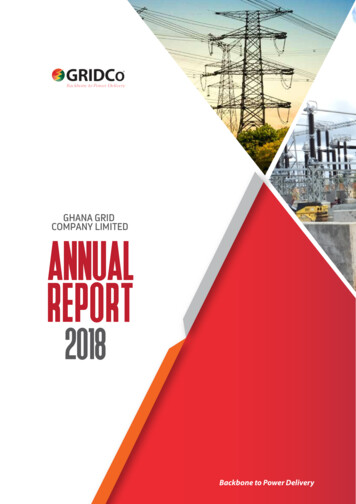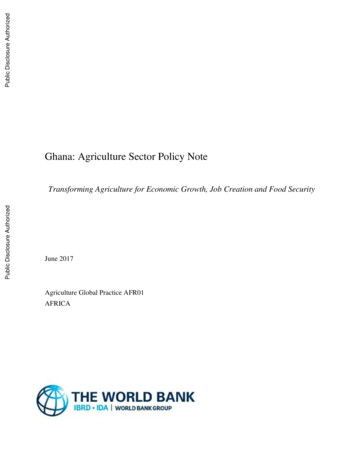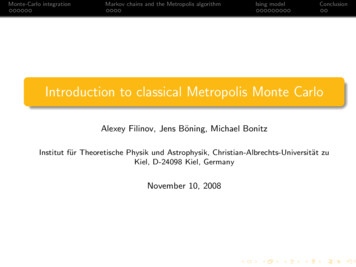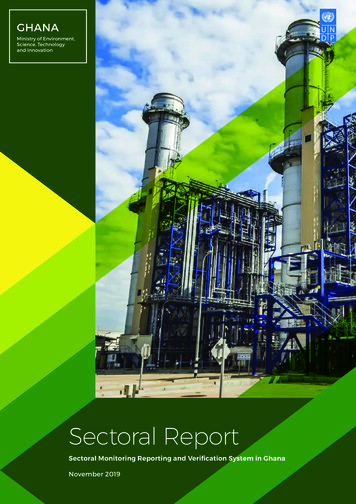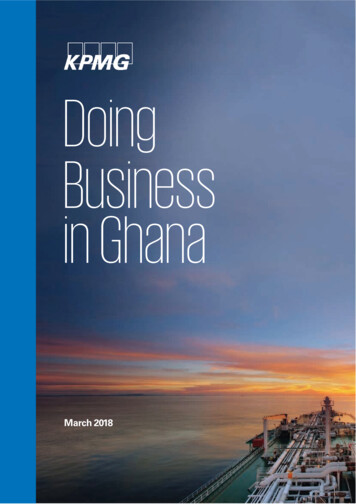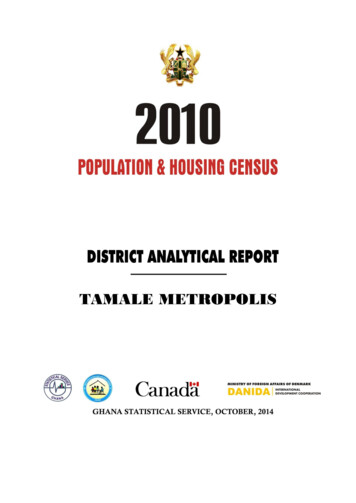
Transcription
TAMALE METROPOLIS
Copyright 2014 Ghana Statistical Serviceii
PREFACE AND ACKNOWLEDGEMENTNo meaningful developmental activity can be undertaken without taking into account thecharacteristics of the population for whom the activity is targeted. The size of the populationand its spatial distribution, growth and change over time, in addition to its socio-economiccharacteristics are all important in development planning.A population census is the most important source of data on the size, composition, growthand distribution of a country’s population at the national and sub-national levels. Data fromthe 2010 Population and Housing Census (PHC) will serve as reference for equitabledistribution of national resources and government services, including the allocation ofgovernment funds among various regions, districts and other sub-national populations toeducation, health and other social services.The Ghana Statistical Service (GSS) is delighted to provide data users, especially theMetropolitan, Municipal and District Assemblies, with district-level analytical reports basedon the 2010 PHC data to facilitate their planning and decision-making.The District Analytical Report for the Tamale Metropolis is one of the 216 district censusreports aimed at making data available to planners and decision makers at the district level. Inaddition to presenting the profile of the metropolis, the report discusses the social andeconomic dimensions of demographic variables and their implications for policy formulation,planning and interventions. The conclusions and recommendations drawn from the report areexpected to serve as a basis for improving the quality of life of Ghanaians through evidencebased decision-making, monitoring and evaluation of developmental goals and interventionprogrammes.For ease of accessibility to the census data, the report for Tamale Metropolis and other censusreports produced by the GSS will be disseminated widely in both print and electronicformats. The report will also be posted on the GSS website: www.statsghana.gov.gh.The GSS wishes to express its profound gratitude to the Government of Ghana for providingthe required resources for the conduct of the 2010 PHC. While appreciating the contributionof our Development Partners (DPs) towards the successful implementation of the Census, wewish to specifically acknowledge the Department for Foreign Affairs, Trade andDevelopment (DFATD) formerly the Canadian International Development Agency (CIDA)and the Danish International Development Agency (DANIDA) for providing resources forthe preparation of all the 216 district reports. Our gratitude also goes to the Metropolitan,Municipal and District Assemblies, the Ministry of Local Government, Consultant Guides,Consultant Editors, Project Steering Committee members and their respective institutions fortheir invaluable support during the report writing exercise. Finally, we wish to thank all thereport writers, including the GSS staff who contributed to the preparation of the reports, fortheir dedication and diligence in ensuring the timely and successful completion of the districtcensus reports.Dr. Philomena NyarkoGovernment Statisticianiii
TABLE OF CONTENTSPREFACE AND ACKNOWLEDGEMENT .iiiLIST OF TABLES . viLIST OF FIGURES .viiACRONYMS AND ABBREVIATONS .viiiEXECUTIVE SUMMARY . ixCHAPTER ONE: INTRODUCTION . 11.11.21.31.41.61.7Background . 1Location, Size and Physical Features . 1Political and Administrative Structure . 4Social and Cultural Structure . 4Census Methodology, Concepts and Definitions . 8Organization of the Report . 18CHAPTER TWO: DEMOGRAPHIC CHARACTERISTICS. 202.12.22.32.4Introduction . 20Population Size and Distribution . 20Age Dependency . 21Fertility and Morality, Migration . 22CHAPTER THREE: SOCIAL CHARACTERISTICS . 283.13.23.33.43.53.6Introduction . 28Size, Household Composition and Headship . 28Marital Status . 30Nationality . 34Religious Affiliation . 35Literacy and Education. 35CHAPTER FOUR: ECONOMIC CHARACTERISTICS . 394.14.24.34.44.54.6Introduction . 39Economic Activity Status . 39Occupation . 42Industry. 42Employment Status . 43Employment Sector . 44CHAPTER FIVE: INFORMATION COMMUNICATION TECHNOLOGY . 465.15.25.35.45.5Introduction . 46Ownership of Mobile Phones . 46Use of Internet . 46Household Ownership of Fixed Telephone Lines . 46Household Ownership of Desktop or Laptop Computer . 47CHAPTER SIX: DISABILITY . 486.16.2Introduction . 48Population with disability. 48iv
6.36.46.56.5Types of disability . 48Disability by type of locality . 48Disability and Economic Activity . 49Disability and level of education . 51CHAPTER SEVEN: AGRICULTURAL ACTIVITIES . 547.17.27.3Introduction . 54Households in Agriculture . 54Types of farming activities . 54CHAPTER EIGHT: HOUSING CONDITIONS . 568.18.28.38.48.58.68.78. 8Introduction . 56Housing stock . 56Types of dwelling, holding and tenancy agreements . 56Construction Material . 58Room occupancy . 59Access to Household utilities and facilities. 60Main sources of water for drinking and other domestic purposes . 61Bathing and toilet facilities . 62CHAPTER NINE: SUMMARY OF FINDINGS, CONCLUSIONS AND POLICYIMPLICATIONS . 659.19.29.39.4Introduction . 65Summary of findings . 65Conclusion. 68Policy Implications . 69REFERENCES . 71APPENDICES . 72LIST OF CONTRIBUTORS . 74v
LIST OF TABLESTable 2.1: Population by Age, Sex and type of locality . 20Table 2.2: Reported total fertility rate, general fertility rate and crude birth rate by district 23Table 2.3: Female population 12 years and older by age, children ever born, childrensurviving and sex of child . 24Table 2.4: Total population, on deaths in household and crude death rate by district . 25Table 2.5: Causes of death in households . 26Table 2.6: Birthplace by duration of residence of Migrants . 27Table 3.1: Stock of houses and households by type of locality . 28Table 3.2: Household population by composition and sex . 29Table 3.3: Household population by structure and sex . 30Table 3.4: Persons 12 years and older by sex, age group and marital status . 31Table 3.5: Persons 12 years and older by sex, marital status and level of education . 33Table 3.6: Persons 12 years and older by sex, marital status and economic activity status. 34Table 3.7: Population by nationality and sex . 35Table 3.8: Population by Religion and Sex . 35Table 3.9: Literacy level of persons 11 years and older by sex and age and literacy status . 36Table 3.10: Population 3 years and older by level of education, school attendance and sex . 38Table 4.1: Population, 15 years and older by activity status and sex . 40Table 4.2: Economic activity status of population 15 years and older by sex and age . 41Table 4.3: Employed population 15 years and older by occupation and sex . 42Table 4.4: Employed population, 15 years and older by industry and sex . 43Table 4.6: Employed population 15 years and older by employment sector and sex . 45Table 5.1: Population 12 years and older by mobile phone ownership internetfacility usage, and sex . 46Table 5.2: Households having desktop/laptop computers, fixed telephonelines and sex of head . 47Table 6.1: Population by type of locality, disability type and sex . 49Table 6.2: Population 15 years and older with disability by economic activity . 50status and by sex . 50Table 6.3: Population 3 years and older by sex, disability type and level of education . 52Table 7.1: Households by agricultural activities and locality . 54Table 7.2: Distribution of livestock and keepers . 55Table 8.1: Stock of houses and households by type of locality . 56Table 8.2: Type of occupied dwelling unit by sex of household head and type of locality . 57Table 8.3: Ownership status of dwelling by sex of household heads and type of locality . 57Table 8.4: Main construction material for outer wall of dwelling unit by type of locality . 58Table 8.6: Main construction material for roofing of dwelling unit by type of locality . 59Table 8.7: Household size and number of sleeping rooms occupied in dwelling unit . 59Table 8.8: Main source of lighting of dwelling unit by type of locality . 60Table 8.9: Main source of cooking fuel, and cooking space used by households . 61Table 8.10: Main source of water of dwelling unit for drinking and other domesticpurposes . 62Table 8.11: Bathing facility and toilet facilities used by household . 63Table 8.12: Method of rubbish and liquid waste disposal by households . 64Table A1: Total population, sex, number of households and houses in the . 7220 largest communities . 72Table A2: Population by age groups in the 20 largest communities . 73vi
LIST OF FIGURESFigure 1.1: Map of the Tamale Metropolis . 2Figure 1.2: Temperature Ranges of the Metropolis . 3Figure 1.3: Rainfall and Temperature Ranges . 3Figure 1.4: Picture of a Feeder Road . 6Figure 1.5: Picture of the New Tamale Sports Stadium . 7Figure 1.6: Adongo Art and Craft shop in Tamale . 8Figure 2.1: Population pyramid . 21Figure 2.2: Reported age specific death rates by sex . 26Figure 3.1: Marital status in the Metropolis. 31Figure 4.2: Employed population, 15 years and older by employment status and sex . 44vii
ACRONYMS AND ABBREVIATONSCBRCrude Birth RateCEBChildren Ever BornCERGISCentre for Geographical and Information SystemsCIDACanadian International Development AgencyCSChildren SurvivingDANIDADanish International Development AgencyDCDDistrict Co-ordinating DirectorDCEDistrict Chief ExecutiveEAEnumeration AreaECOWASEconomic Community of West African StatesFCUBEFree Compulsory Universal Basic EducationGFRGeneral Fertility RateGSSGhana Statistical ServiceICTInformation Communication TechnologyIMISIntegrated Management Information SystemJHSJunior High SchoolJSSJunior Secondary SchoolL.ILegislative InstrumentMMDAsMetropolitan, Municipal, District AssembliesNGONon-Governmental OrganisationPHCPopulation and Housing CensusPWDsPersons with DisabilitiesSHSSenior High SchoolSSSSenior Secondary SchoolTFRTotal Fertility RateUNUnited NationWCWater Closetviii
EXECUTIVE SUMMARYIntroductionThe Census Report for the Tamale Metropolis is the first of its kind since the first postindependence census was conducted in 1960. The report provides basic information about theMetropolis. It gives a brief background of the Metropolis, describing its physical features,political and administrative structure, socio-cultural structure and economy. Using data fromthe 2010 Population and Housing Census (2010 PHC), the report discusses the populationcharacteristics of the Metropolis, fertility, mortality, migration, marital status, literacy andeducation, economic activity status, occupation, employment; Information CommunicationTechnology (ICT), disability, agricultural activities and housing conditions of the metropolis.The key findings of the analysis are as follows (references are to the relevant sections of thereport).Population size, structure and compositionThe population of Tamale Metropolis, according to the 2010 Population and Housing Census, is233,252 representing 9.4 percent of the region’s population. Males constitute 49.7 percent andfemales represent 50.3 percent. The proportion of the population living in urban localities(80.8%) is higher than that living in rural localities (19.1%) of the metropolis. The metropolishas a sex ratio of 99.1. The population of the metropolis is youthful (almost 36.4% of thepopulation is below 15 years) depicting a broad base population pyramid which tapers off witha small number of elderly persons (60 years and older) representing 5.1 percent. The total agedependency ratio for the district is 69.4, the age dependency ratio for rural localities is higher(86.5) than that of urban localities (65.7).Fertility, mortality and migrationThe Total Fertility Rate for the metropolis (2.8) is slightly lower, compared to the regionalfertility rate of 3.5. The General Fertility Rate is 79.9 births per 1000 women aged 15-49 years.The Crude Birth Rate (CBR) is 21.2 per 1000 population. The crude death rate for themetropolis is 5.6 deaths per 1000. Accident/violence/homicide/suicide account for 9.6 percentof all deaths while other causes contribute to 90.5 percent of deaths. Majority of migrants (54.9percent) living in the metropolis were born elsewhere in the region while 45.1 percent wereborn elsewhere in another region. For migrants born elsewhere in another region, those born inhave the highest proportion (19.6%) followed by those who were born in Upper East (18.7).Household Size, composition and structureThe metropolis has a total of 219,971 households, living in 19,387 houses. The averagehousehold size in the metropolis is 6.3 persons per household. Children constitute the largestproportion of the household structure accounting for 40.4 percent and heads of householdmake-up 16.1 percent of the household population. Spouses form about 9.4 percent and otherrelatives constitute 12.9 percent of the population. The proportion of households who live inextended household structure (head, spouse(s), children and head’s relatives) constitute thelargest proportion (46.1%) than that of any other type of household structure. Nuclearhouseholds (head, spouse(s) and children) constitute only 19.5 percent of households in themetropolis.ix
Marital statusThere are more people (48.6%), 12 years and older, who are married than those who havenever married (44.2%). Persons who are widowed constitute 4.0 percent of the population ofthe metropolis. Population of divorced make-up 1.6 percent while those in consensualrelationships constitute only 0.7 percent. The highest percentages (57.5 and 23.3 respectively)of married persons either had no education or attained only basic education. About 31 percentof persons who have never married are employed, compared to 4.8 percent who areunemployed. The largest proportion (63.8%) of them are economically not activeNationalityThere is a dominant proportion of Ghanaians by birth in the metropolis, constituting 94.6percent of the population. Those who have naturalised constitute less than one percent (0.8)while those who have dual nationality are 2.1 percent of the total population of themetropolis.Literacy and educationOf the population 11 years and above, 60.1 percent are literates and 39.9 percent are nonliterates. The proportion of literate males (69.2%) is higher than that of females (51.1%). Fiveout of ten people (54.8%) indicate they can speak and write both English and Ghanaianlanguages. Of the population aged 3 years and older (84,897) currently attending school inthe metropolis 52.9 percent are males and the remaining 45.1 percent are females. Amongthose who have attended school in the past, males constitute 58.6 percent and the femalesrepresent 41.4. It indicates that both among those who attended school in the past and thosewho are currently, males have higher proportions. Among those currently attending school,15.1 percent are in nursery, 18.2 percent in JSS/JHS, 12.5 percent in SSS/SHS and the largestproportion (40.0%) is in primary. Only 5.7 percent of the population 3 years and older in themetropolis are currently attending tertiary institutions.Economic Activity StatusAbout 63.3 percent of the population aged 15 years and older in the metropolis areeconomically active and 36.7 percent are economically not active. Of the economically activepopulation, 92.6 percent are employed while 7.4 percent are unemployed. For those who areeconomically not active, a larger percentage of them are students (56.0%), 20.9 percentperform household duties and 12.4 percent are either too young or old to work. About fiveout of ten (52.9) of unemployed persons in the metropolis are seeking work for the first time.OccupationOf the employed population in the Tamale Metropolis, the highest proportion (33.0%) areengaged as service and sales workers. The second largest occupation is craft and related tradeworkers who constitute 21.5 percent of the employed population. The number of skilledagricultural, forestry and fishery workers represent 17.6 percent of the employed population.Those employed as professionals constitute only 8.1 percent.Employment status and sectorOf the population 15 years and older, the highest proportion (60.6%) are self-employedwithout employees, 19.5 percent are employees, 5.9 percent are contributing family workersand 6.9 percent are self-employed with employees. Higher proportion of females are selfx
employed without employees (70.5%), compared to 51.3 percent for males. The proportion offemales who are employees (11.3%) is however smaller than that of male employees(28.2%). The private informal sector is the largest employer in the metropolis, employing83.2 percent of the employed population. Public sector is the next highest employer,engaging 11.3 percent of the employed population.Information Communication TechnologyOf the population 12 years and above, 53.7 percent have mobile phones. The proportion ofmales who own mobile phones (55.5%) is higher than that for females which 44.4 percent.Only about 7.4 percent of the population 12 years and older use internet facilities in themetropolis and a 9.5 percent of the total households have desktop/laptop computers.DisabilityAbout 2.0 percent of the total population of the metropolis has one form of disability or theother. Almost equal proportions of both females and male in the population suffer disability.The types of disability in the metropolis include sight, hearing, speech, physical, intellect, andemotion. Emotional disability is the commonest form of disability in the metropolis, affecting29.1 percent of the disabled population. The second commonest is sight disability which alsoaffects 26.8 percent. About 48.7 percent of the disabled population are employed, 3.9 percentunemployed and 47.3 percent are economically not active. In terms of education, less than 0.1percent of persons with disability in the metropolis obtained post-graduatecertificate/diploma/ masters or PhD.AgricultureOnly a small proportion (26.1%) of households in the metropolis are engaged in agriculture.In the rural localities, the proportion of households engaged agricultural (43.3%) is less thanthat of urban households which is 56.7 percent. Most (84.8%) of the agricultural householdsin the metropolis are involved in crop farming, 52.9 percent in urban and 47.1 percent in rurallocalities. Fishing farming is the agricultural activities that engages the least proportion (lessthan 0.1%) of households in the metropolis.HousingThe housing stock of Tamale Metropolis is 19,387 representing 7.5 percent of the totalnumber of houses in the Northern Region. There are a total of 35,408 households and theaverage number of persons per house is 11.5. Average household size for the metropolis is6.3, which is lower than the regional average of 7.8.Type, tenancy arrangement and ownership of dwelling unitsThe most dominant type of dwelling in the metropolis is compound house, constituting 80.6percent of dwellings. Separate house type of dwelling which is the next commonest onlyconstitute 7.5 percent of dwellings. Huts/building (same compound) type of dwellingsconstitute 4.3 percent, semi-detached houses make-up 3.4 percent and flats/Apartment 2.1percent. About 55 percent of the dwelling units in the metropolis are owned by members ofthe household. Personal ownership of dwellings is higher among male headed households(57.1%) than female headed households (47.1%). Public/Government owned dwellingsconstitute only 2.9 percent of dwellings in the metropolis.xi
Material for construction of outer wall, floor and roofThe main construction material for outer walls of dwelling units in the metropolis are cementblocks/concrete which constitute the material used for constructing the outer walls of aproportion 55.9 percent of dwelling units. In urban localities, the proportion is higher (60.3%)than that of rural localities where only 36.8 percent of outer walls of dwelling units wereconstructed using cement blocks/concrete. The use of mud/brick/earth which constitute 35.2is also significant in the metropolis. They constitute the main material used in constructingthe outer walls of 30.0 percent of dwelling units in urban localities and 57.5 percent in rurallocalities. Cement (83.9%) and mud/earth (13.6%) are the two main materials used in theconstruction of floors of dwelling units in the metropolis. Metal sheets are the commonestmain roofing materials, constituting about 85.3 percent of roofing materials of dwellings. Thesecond commonest is thatch/palm leaf or raffia which are used for roofing 9.1 percent ofdwellings.Room occupancyOne sleeping room occupancy is the commonest among all households of various sizes.About 87.7 percent of single member households occupy dwelling units with one sleepingroom. On one hand, 3.3 percent of households of sizes 10 or more occupy single rooms inthe metropolis. On the other hand, about two percent of single member households in themetropolis occupy nine rooms or more.Utilities and household facilitiesThe three main sources of lighting for most households are electricity (main grid),constituting what lights 82.2 percent of households, kerosene lamp (11.6%) andflashlight/torch, constituting the source of light for 4.7 percent of households in themetropolis. Most households in the metropolis use two main sources of cooking fuel;charcoal, which is used by 94.3 percent of households in urban location and 5.7 percent ofrural households and wood, which is used by 52.9 percent of households in urban localitiesand 47.1 percent of rural localities. Gas is the third commonly used fuel for cooking used by89.6 percent or urban households and 10.4 percent of rural households. Most households inthe metropolis depend on either pipe-borne water outside their dwelling or pipe-borne waterinside their dwelling (representing 41.4% and 39.8% respectively).The commonest toilet facility is used by 56.2 percent of households in the metropolis and thatis public toilet (WC/KVIP/Pit latrine/pan). The use of KVIP is the second commonest usedby just 7.1
The population of Tamale Metropolis, according to the 2010 Population and Housing Census, is females represent 50.3 percent. The proportion of the population living in urban localities (80.8%) is higher than that living in rural localities (19.1%) of the metropolis. The metropolis has a sex ratio of 99.1.
